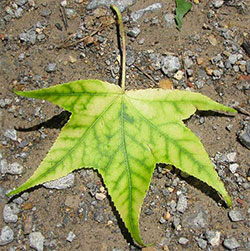
Iron is an essential nutrient for plant growth. Western alkaline soils (>pH 7.2) generally contain high levels of iron. However, iron in such soils is often bound up in forms which some plants cannot absorb. This leads to iron deficiencies in such plants which manifests as iron chlorosis. Iron chlorosis appears as yellowing between leaf veins while the veins remain green. Symptoms first occur on the youngest leaves.
Other soil factors that contribute to iron deficiency include; overly wet or dry soils, soil temperature extremes and poor soil aeration caused by compaction or over watering. Iron chlorosis symptoms are common during cool wet springs. Susceptibility to iron deficiency varies greatly among plants. Some plant species tolerant to high pH/low plant available iron conditions and avoid iron chlorosis problems.
For some species iron chlorosis can avoided by eliminating springtime over-watering and improving soil aeration. For more susceptible species chelated iron fertilizers, foliar iron applications or iron injections may be necessary to correct the issue.
For more detailed information see: Iron Chlorosis



